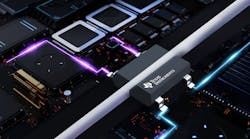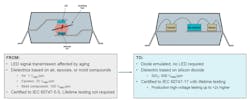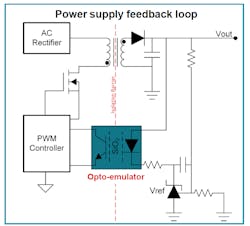What you’ll learn
- The importance of signal isolation in high-voltage design
- The difference between optocouplers and opto-emulators
- Details on TI’s silicon dioxide (SiO2) isolation technology
Isolation is invaluable in everything from industrial motor drives on factory floors to electric-vehicle (EV) traction inverters, where it’s necessary to deter dangerous high voltages from entering the more fragile parts of the system.
Optocouplers have been the “go-to” for isolating analog and high-speed digital signals traveling through power supplies and systems for decades, enhancing reliability and safety in the process, said Tsedeniya Abraham, VP and GM of interface products at TI. She added that while they can facilitate the safe transfer of signals and data from the input stage in a power supply and its output terminals or load, the optocoupler is no longer cutting it as power levels rise in the automotive and industrial sectors.
TI is trying to bring the optocoupler into the future with a new family of what it calls “opto-emulators.” Based on its silicon-dioxide (SiO2) isolation technology, the parts are pin-to-pin alternatives to optocouplers for high-voltage signal isolation. And the company claims they bring better power efficiency, signal integrity, and reliability to the table while extending the lifespan of high-voltage industrial and automotive systems.
TI, which is entering the optocoupler market for the first time with its digital-output ISOM8710 and ISOM8711 and the analog-output ISOM8110, said they can slot into virtually any high-voltage power system where optocouplers are used today.
That includes EV traction inverters and onboard chargers (OBCs), industrial motor drives, programmable logic controllers (PLCs) and other factory automation and control systems, as well as lighting systems and solar, wind, or other renewable-energy inverters for the grid.
“These are drop-in replacements for optocouplers that are reliable and robust, and, at the same time, they have better signal performance over a wider range of temperatures,” said Azhar Mohammad, TI’s head of isolation product management.
The Importance of Isolation in High-Voltage Systems
In any system that operates at voltages rising to several hundred or even thousands of volts, isolation is indispensable to prevent hazardous high voltages from straying into sections of the system not specifically designed to handle them. Enhancing reliability and safety is the other advantage of opto-emulators and other high-voltage isolators, as they’re able to withstand high-voltage surges and power-supply spikes.
Galvanic isolation—in the parlance of the power electronics industry—is used in particular to prevent the flow of direct current (DC) and unwanted alternating current (AC) between different parts of a circuit or system while enabling the safe transfer of signals, power, and data. Protecting humans close to high-voltage systems from shock hazards is also the responsibility of galvanic isolation.
In addition, galvanic isolation is useful for connecting the sections of a power supply that have different ground potentials or breaking ground loops by stopping current flow between sections sharing a ground. That is valuable in erasing noise for high-voltage systems. When power supplies are tied together in the same system, ground loop currents tend to be induced due to slight differences in ground potential.
“Wherever high voltage is in play, isolation will go hand in hand,” said TI’s Mohammad.
Oftentimes, designers looking to add high-voltage signal isolation to a system will turn to optocouplers. They’re typically used to isolate the high- and low-voltage zones of a system or eliminate the electrical noise coupling from signals traveling through a power supply or other type of system (Fig. 1).
Driven by the pulse-width-modulation (PWM) signal from the microcontroller (MCU) that controls the power supply, the optocoupler is turned on by input current and then uses the LED inside to transfer the signal to the photodetector on the other side of the same package. These parts transfer analog or digital signals through a void of glass, plastic, or even empty space that serves as the isolation barrier. But these materials do have limitations, requiring more physical separation to hit higher isolation levels, said TI.
In general, optocouplers can be applied to everything from input and output switching of the processor in a system to DC and AC power control. They’re also useful for regulating the power supply's output voltage. When output voltage deviates either due to line and/or load changes, the power supply’s MCU adjusts the PWM output. In turn, the PWM directs the power MOSFET on the primary side via the optocoupler.
Can the Opto-Emulator Take the Optocoupler’s Place?
Optocouplers are constantly improving. But as higher voltages and power levels become the standard in industrial and automotive systems, TI contends that existing optocouplers aren’t evolving fast enough.
Voltage levels are rising, including in EVs, where high-voltage battery packs are becoming the rule rather than the exception. But according to TI, high-voltage reliability and long-term robustness are areas where traditional optocouplers are lacking. They also typically consume more power due to variations over time in how efficiently they can transfer current, and they are falling behind in bandwidth, which affects response times to load transients.
TI explained that it uses semiconductor technologies in its opto-emulators to recreate how optocouplers work. The isolation barrier itself is based on TI’s proprietary SiO2 isolation technology, which is said to deliver more robust insulation properties compared to the usual forms of isolation inside optocouplers.
As a result, TI claims the opto-emulators are more robust in the long run than standard optocouplers. The optocoupler's insides tend to degrade over time. Thus, its performance erodes due to aging, too, which can be detrimental to automotive- and industrial-grade power supplies that are designed to remain in use for decades while being subject to harsh environmental conditions. As a result, optocouplers require up-front overdesign to counteract the aging of the LED.
Even the isolation barrier inside the optocoupler can degrade over time due to the stress of constant exposure to high voltages. In contrast, TI touted the very high dielectric strength of its silicon-based isolation technology, giving the opto-emulators more robust isolation properties that can last 40 years or more without deteriorating.
To further enhance reliability and safety, the opto-emulators are based on a unique construction that unites several layers of the isolation material for high-voltage protection. The design helps prevent any single point of failure in the device, adding another layer of durability.
One of its other key characteristics is its resistance to moisture. According to TI, SiO2 doesn’t degrade when exposed to ambient moisture for extended periods of time, improving its robustness in the long run.
Inside the Opto-Emulator: Robust Isolation Ratings
TI said the first chips in the new opto-emulator family are footprint-compatible with many of the most popular optocouplers on the market, making them easy to integrate into existing designs.
With operating voltages of up to 500 V RMS, the opto-emulators maintain a maximum isolation rating of up to 3.75 kV RMS. The components can also withstand voltage surges of up to 10 kV.
Besides handling constant high voltages and voltage spikes, optocouplers and other isolation devices must withstand switching noise. Common-mode transient immunity (CMTI) is the maximum tolerable rate of rise or fall (also called the slew rate) of the common-mode voltage that runs between the low and high side of a system without interrupting signal integrity or interfering with a power supply’s PWM. The capacitance between isolated ground planes can cause transient voltages to breach the isolation barrier.
TI said the ISOM8710 features a minimum CMTI of ±85 kV/μs, while it typically supports 150 kV/ μs, which helps both sides of a high-voltage power supply operate within specifications even when exposed to fast transient events.
Furthermore, the chips have a very short propagation delay and reduced pulse-width distortion (PWD). These are useful properties in power supplies at the heart of traction inverters in the EV and industrial motor drives that increasingly operate at fast switching frequencies and, in turn, tend to see more transient noise. Electrical noise can interfere with the MCU that outputs the PWM signals to control high-voltage power supplies.
Will Opto-Emulators Work for Switching Power Supplies?
The new single-channel opto-emulators, which are designed to deliver digital or analog outputs over a temperature range as wide as −55 to 125°C, offer faster data rates and wider bandwidths that improve load transient responses.
TI said the opto-emulators are suited for high-speed systems, as the chips support stable performance over temperature and aging. They can deliver data rates of up to 25 Mb/s and can output 3.3- and 5-V signals with different digital logic outputs: CMOS-compatible output (ISOM8710) or open drain output (ISOM8711). The ISOM8110, which outputs analog signals, has a high bandwidth of 680 kHz.
Opto-emulators also edge out optocouplers in terms of power efficiency, according to the company. Primarily by limiting supply current (ICC)—the average current consumed in a no-load situation between a power supply and ground terminals—TI said opto-emulators consume up to 80% less power at a component level. These power savings stack at the system level depending on the number of channels in the power supply that must be galvanically isolated.
“It ultimately depends on the system design and the voltages being used, but essentially, the more devices that you use to replace optocouplers, the more power savings you will see compared with optocouplers,” said Mohammad.
TI also said the chips transfer current from the primary to secondary sides of a system more reliably over a wider range of temperatures than existing optocouplers, helping keep output regulation tight and stable over time.
As a result, one potential application for the opto-emulators is output regulation on the secondary or high-voltage side of a switched-mode power-supply (SMPS) design based on the flyback converter topology, one of the most widely used power topologies (Fig. 2).
A Pin-to-Pin Replacement for the Optocoupler?
Besides performance, TI said it also focused on ease of use when it was working on the opto-emulators.
It offers the new opto-emulators in the same packaging footprints as existing optocouplers. According to the company, using them requires no alterations to the system design or the positioning of components on a PCB.
“We are trying to solve the problems with optocouplers in a different way, albeit while staying within the same footprint and having the same look and feel of optocouplers,” said Mohammad. “For customers, it’s a drop-in replacement. Take the optocoupler out and put the opto-emulator in. You can continue to send current as the input and the [analog or digital] output will be exactly the same as expected from the optocoupler.”
The new high-voltage signal isolators are integrated into five- and four-pin SOIC packages with footprints of about 4.5 to 5 mm wide and 3.5 to 3.8 mm high, while featuring up to 5 mm of creepage.
TI said that it plans to roll out a broader range of packaging options for its opto-emulators in the future.


